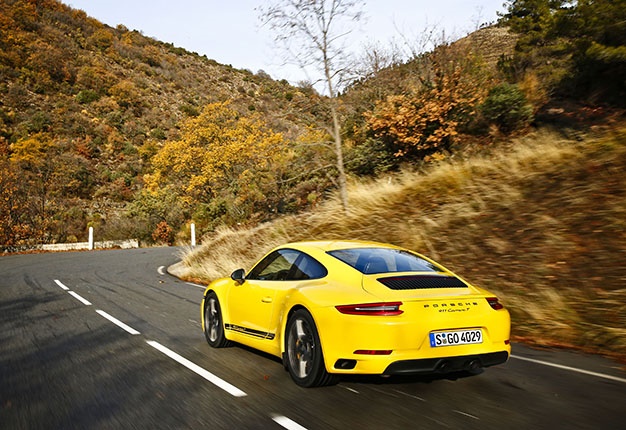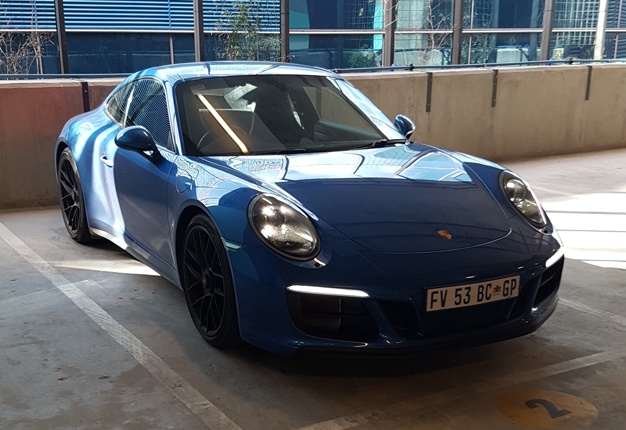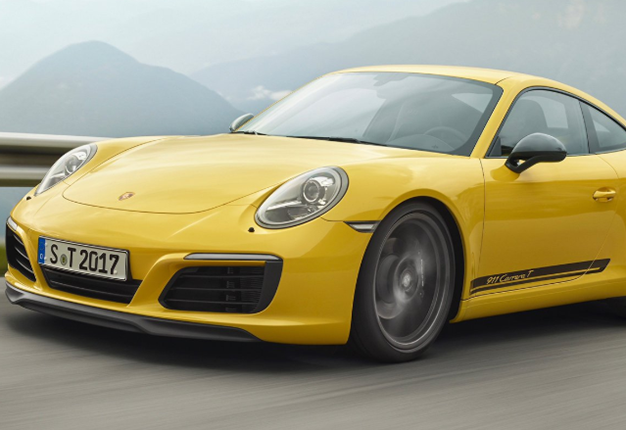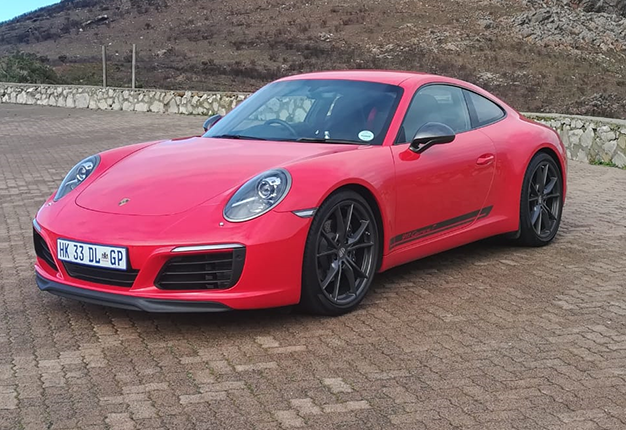The midway point of Porsche’s 911 series is defined by wheels that straddle sports car territory, on the one hand, and racing car aspirations on the other: the GTS. One step up delivers the GT3. How do they differ and compare?
911 GTS a wide-bodied Carrera
The latest GTS enjoyed its world launch at Cape Town’s Killarney race track in January last year. The event coincided with the world launch of the new Porsche Panamera.
READ: Carrera T, GTS, GT3, GT2 RS... latest Porsche sports car quartet in SA: How the legendary 911 changed the way performance cars are perceived forever
The GTS – available in coupe, cabriolet and Targa body styles and with a choice between rear or all-wheel-drive – splits the difference between road orientated 911’s (like the Carreras) and those geared for track work or truly stellar performance (like the Turbo and GT models).
To put numbers on it: The Carreras operate in the zone around 300kW (from 272-309kW). The GT and Turbo models buzz around 400kW (from 368 to 427kW – with an insane stretch to 515kW for the GT2 RS). The GTS, however, centres the graph at 331kW.
Porsche, therefore, won’t generally group the GTS, on info sheets, with the rest of the 911 family carrying a Carrera moniker, even though a quick glance at the fine print will confirm that the car is indeed indexed as a Carrera.
Take further note that the GTS is not a narrow-bodied Carrera. The option of an all-wheel-drive GTS dictated the wider body utilized by all-wheel drive 911’s, commonly denoted by a '4' in the nomenclature: Carrera 4, Carrera 4S, Targa 4S, Carrera 4 GTS, etcetera.
In this way, the GTS, uniquely, straddles the divide between Carrera and non-Carrera – or, if you wish, the divide between 911 as a sports car and 911 as an instrument of maximum attack.
GTS: From sports car to race car
So, how does it do this? How does GTS transition from spicy bourgeois to battle-hardened breker?
Well, it’s got to look the part and it’s got to boast the requisite accoutrements. That’s why the GTS is decked out with smoked lenses, a black exhaust, black side mirrors, satin black wheels with centre-locking, black Alcantara for seats plus the steering wheel and a Sport Chrono pack including Porsche’s new Track Precision app.
Image: Janine Van der Post / Wheels24
The real differentiator, though, is a gain in power. And since bore and stroke are unchanged and since all 911 engines utilize VarioCam Plus (which continually adjusts valve timing and valve lift), that gain – up from the Carrera’s 272kW to the GTS’s 331kW – cannot be explained through timing or capacity.
That leaves a sports exhaust plus turbo-sizing and boost; the GTS is charged by two bigger and meatier BorgWarner's even than the Carrera S, expanding boost from 1.1 bar for the latter to 1.25 bar.
READ: Special off-road Porsche for German WRC: Cayman GT4 Clubsport set to light up the field
Yet, power is nothing without control. For this reason, GTS suspension has also been dropped by 20mm (or 10, compared to the Carrera S’s), whilst a wider track (courtesy of the 44mm wider body) carries 305mm section gumballs at the rear, to combine massive grip with astonishing body control, the latter part as a result of PASM’s super-quick electronic dampers plus the optional PDCC’s active anti-roll bars.
Image: Supplied
Add better aero, 911 Turbo brakes and torque vectoring, plus optional rear axle steering (a must-have at R41 000) and the GTS boasts a formidable technical arsenal, easily capable of handling the engine’s extra grunt with enough poise to step onto a race track any day of the week.
Correction. Make that every day of the week. Porsches are tough. They can take it. The GTS is, therefore, a road car suitable for track use. The GT3, as a donor car to the GT3 RS, is virtually a track car suitable for road use.
GTS vs. GT3: Power and consumption
How do the two stack up against each other? Pretty well, especially on the road. Don’t be fooled by 331 versus 368 kW. That’s a proper gap, only if you consider peak power.
In terms of torque, though, GTS smashes GT3. The latter’s normally-aspirated 4.0-litre peaks at 460Nm, delivered at 6 000 revs; the smaller-capacity turbo-charged unit delivers 550Nm all the way from 2 150 to 5 000rpm.
Image: Porsche
Choose a manual box on both cars and from 0-100 km/h the GTS is only 0,2 seconds slower (4,1 versus 3,9 seconds). The lag is not so much in engine performance, but rather attributable to extra weight (1450kg for the GTS; 1413kg for the GT3).
The PDK box lumps another 20 kg onto the GTS, but with decreased cog swopping intervals, the GTS PDK (1470kg; 3,7 seconds) topples the GT3 manual in sprints from a standstill.
To take top honours in this specific little battle, you would, therefore, have to go for the GT3 PDK (3.4 seconds). That’s seriously quick, especially as the GT3 smokes its pipe at atmospheric pressures.
Image: Charlen Raymond/Wheels24
Yet, numbers like this also imply heavy drinking. You might therefore not be surprised to learn that the GTS is lighter on fuel than the GT3, but you might be surprised by how much. With a PDK box, the GT3 officially thirsts away at a rate of 12.7 litre/100km, the GTS at 8.3 litre/100km.
At which point you might want to know what the relevance of consumption is when you’re sitting behind the wheel of a Porsche? It’s surely just of academic interest, utterly unrelated to the sheer joy of driving?
Not, take note, when you run the GT3 dry in less than 300km. Having to find a gas station and pull over might just be the moment you’d start pining for a GTS.
And once you’ve driven the GTS in anger, there might be other reasons, too, the first of which is that GTS is incredibly easy to drive on the limit, whilst GT3 is a tad trickier.
GTS dynamics
In comparing GTS to GT3 dynamics, it’s only fair to compare apples with apples. So, rear-wheel drive for both, please. The GT3 is issued in this configuration only, in any case; there is no all-wheel-drive version to counter the traction advantage of a Carrera 4 GTS.
Here’s the point, though, concerning Carrera GTS (sans the “4”): it feels like an all-wheel-drive car in any case, without the vices or corruptions like extra weight or understeer.
Image: Supplied
Porsche just smiled at my suggestion that the “4” had accidentally been knocked off the badge, prior to test car delivery. But I remain convinced that “911 Carrera GTS”, so proudly displayed below the black strip tying the rear light clusters together, was a neat piece of fake news.
It is simply unheard of, for a rear wheel drive car to be this stable and this collected at speeds which should at least hint at the laws of Newtonian physics.
Instead, what you get, is a rocket running on rails. No wiggle. No corrections. No understeer. No oversteer. No corruption. No crisis. No calamity.
Image: The News Market
Just purity and accuracy, hitting one apex after another with laser-like precision, before rocketing out like a torpedo, low and flat, skimming the surface with no noticeable drop off beyond 5 000rpm when the torque wave technically starts to recede, exactly at the point where power delivery takes over to chase the tacho to 7 000 and beyond, before the PDK hooks the next gear with lightning speed.
Flat out, then, in the GTS. And flat out straight off the bat, which is probably the biggest revelation about this car, that the groove can be hit so thoroughly and comfortably and instantaneously, with so much assurance and confidence.
In the GTS, you don’t have to play your eye in. In fact, you can close your eyes and still hit the apex. Or is that just a piece of fake news?
The apex and the exit
Here’s something to take into account: the GTS wheelbase is 7 mm shorter than the GT3’s. Normally, that would make for a quicker turn-in and so it does.
Conversely: GT3 hits peak power at 8 250 r.p.m. versus 6 500 for the GTS, whilst maximum torque arrives at 6 000 r.p.m. versus 5 000.
Consider then, that most medium-radius sweeps of about 130/140/150 km/h in, say, third gear, will have the GTS mill running at around 6 000 r.p.m. through the apex, from where another 1 000-plus revs will be available to pull the car out and onto the straight, all of them beyond the turbo’s torque plateau.
Image: Net Car Show
The GT3 engine will be running at higher revs, at the same point, but will also have a wider band left in which to snort, chasing the next apex.
It is exactly in this phase where you’ve got to have your wits about when driving the GT3 flat out.
Things start to happen pretty damn quickly, but the trickiest part is yet to come, arriving as it does, at the moment of turn-in and, more to the point, in the millisecond thereafter.
Turn-in comparison
Tyre sizes on the two cars are identical (245/35-ZR20’s front; 305/30-ZR20’s rear), so grip is immense, traction enormous. The GTS runs on Pirelli P Zeros, though, and the GT3 on Michelin Pilot Sport Cup 2’s, and this makes a difference on the road.
The GTS reacts almost telepathically to rudder inputs, electrically assisted as it is. And let’s get this out of the way: Porsche has mastered EPS (electric power steering) beautifully, with a linear build in heft, well-weighted resistance, perfect speed, pin-sharp accuracy, proper self-centring, a smooth and fluid action on the wheel and more feel than could ever be expected from electronics.
Image: Porsche
In the GT3, however, there is a moment – when you brake from, let’s say, 190 to 140km/h and then turn in, specifically on a downhill slope – where the front hesitates, in a brief flash of semi-understeer, for a meter or a meter and a half.
To counter, you’ve got to straighten the rudder momentarily and lift. And it’s then, when the equation translates to bite, that there’s a sudden effort from the front tyres to make up for what’s been lost in the preceding moment of understeer.
Image: Porsche
It’s not so much a question of picking up the slack and transitioning to proper grip. It’s more like an on/off switch, commanding the nose – with the car in control – to divert in one foul swoop from the slacker wider line, to a tighter narrower line, the grip kicking in with such venom and surplus that it overwhelms the tail and threatens to throw it wide into the arc’s open recesses.
That’s when your heart would have jumped into your throat if you had time for it. But you don’t. You’ve got to curb the GT3’s tail and counter the boisterous bid for freedom. And you’ve got to do it in a hurry. As in instantaneously. It can be tricky.
Randy Pobst and the banshee shriek
I mentioned this difference between GTS and GT3 turn-in behaviour to Dr Frank-Steffen Walliser, head of Porsche Motorsport for GT racing worldwide, during the international GT2 RS launch at the Portimão track in southern Portugal, at the end of last year.
Walliser is also head of GT production cars. He stared into the distance for a while and then said: “Interesting. That’s exactly what Randy Pobst told me.”
Pobst also called “The Rocket”, is America’s best-known race car driver cum journalist.
The ‘cobra moment’ does then periodically threaten to strike. But do not fear. It only happens if you take the GT3 right to the edge. A g-meter maximum of 1.59 during the test drive confirms that it is only on a menu called extreme, and you obviously don’t have to pull that kind of g’s to appreciate the GT3.
You’d be stupid not to live in the zone above 7 800 revs, though.
Image: Porsche
For it is right there, around 8 000 and above, that the 4.0-litre flat-6 starts to rip a banshee-like howl from the bowls of the earth and the depths of the universe. It is heaven and hell all rolled into one, building to an ear-piercing shriek to rival the beginning and the end of Armageddon.
There is nothing else quite like it on the face of this planet, or in the space between us and Mars, and it doesn’t stop until the tacho hits a dizzying 9 000rpm. It is, quite simply, a shatteringly beautiful noise and utterly addictive.
Which one to buy?
For this alone, the GT3 is worth having a million times over. Yet, how priceless is a great soundtrack, including the “ticks” and “pings” of the cabin’s built-in roll cage?
The GTS Coupé will lighten your overburdened purse to the tune of R1.77 million; the GT3 costs R2.88 million. There’s a million in there, to cover a 718 Cayman, not so?
Image: Janine Van der Post / Wheels24
Thus, the perfect solution would have been to mix GTS assets with GT3 revs and soundtrack, for a split in the price difference. Just think Texas chainsaw massacre shriek, virtually no loss of speed and the turbo car’s extra little in-gear kick, all on the GTS’s slightly more pliable suspension settings and civilised on-the-edge characteristics, plus superior mileage per tank.
But life is never perfect. We have to make choices. Mine? I’d be more than happy to use company money for a GT3. But I’d be ecstatic with the GTS, even if I had to pay for it myself. In Porsche World, there is no bigger bargain.




 Publications
Publications
 Partners
Partners
























